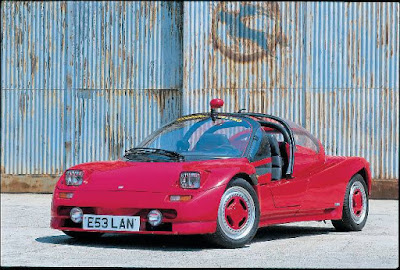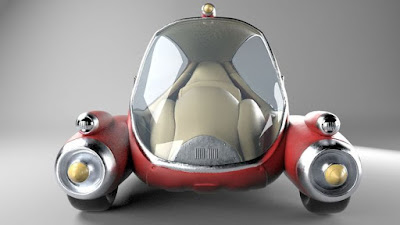Weird ONES In the automotive world, the Giovanni Michelloti's name is very famous as one of the world's greatest car designers. Many of his automotive works have graced various automotive brands in the world ranging from sports cars to trucks. In our beloved Trussty sites, on several occasions we have also discussed the automotive works by the Italian' maestro.
 |
| 1988 Michelotti Pura is a two seater road going sportscar based on the world championship winning Albatech group C2 race car, built by the Albatech for Michelotti Studio under direction of Edgardo Michelotti designed by Tateo Uchida. (Picture from: Classic and Recreation Sportscars) |
As we all knew, the maestro passed away in January 23, 1980. Although the unique car would be discussed was designed and built after the maestro passed away. However it is only propered if the car said to be one of the works ever had created under the great name of Giovanni Michelotti in the late 1980s, due to it's made by the Michelotti Studio, his founded studio of the 1959.
 |
| 1988 Michelotti Pura is made of the fiber and composite materials and has a glass canopy could slide back or even could also be removed of the vehicle. (Picture from: Classic and Recreation Sportscars) |
And the unique car in question was named Michelotti Pura (an Italian word means 'Pure') is the only example of a two seater road going sportscar based on the world championship winning Albatech group C2 race car or effectively, a F3 road car. The car built by Michelotti Studio under the direction of Edgardo Michelotti (son of Giovanni Michelotti), designed by a Japanese designer named Tateo Uchida.
 |
| 1988 Michelotti Pura is powered by a mid-mounted Alfa Romeo 4-cylinder 1.8-liter turbocharged engine coupled with a ZF 5-speed transmission. (Picture from: MichelottiPura) |
The two seater Pura sports car weighed only 1,4313 lbs and powered with a mid-mounted Alfa Romeo 4-cylinder 1.8-liter turbocharged engine coupled with a ZF 5-speed transmission. The light weight was made possible by the vehicle’s body made of the fiber and composite materials. The glass canopy could slide back or even could also be removed of the vehicle. The intenor consisted of a standard instrument panel with analog instruments.
 |
| 1988 Michelotti Pura prototype is tested and developed in the Fiat wind tunnel, the aerodynamics of the Pura were very ahead of its time for a road car. (Picture from: Classic and Recreation Sportscars) |
The
car project done by the Albatech (the Mario Colucci & Georgio Striano's
company), and it is built in carbon fibre and aluminium (carbon-fibre composite
chassis) with ground effect body styling offering a power to weight
ratio of 4,2-3kgs per hp. With the Colucci and Stirano's input, so the Pura
has a real racing pedigree. The prototype is tested and developed in the Fiat wind tunnel, the aerodynamics of the Pura were very ahead of its time for a road car.
 The prototype known as the only one model ever made and also has many advanced aerodynamic engineering details that predate of the Lotus Elise or Renault Spider and the McLaren's use of carbon fibre composite in 1992. No wonder, if In general the Pura sports car prototype could be said to be an automotive creation that was born far ahead of its time.
The prototype known as the only one model ever made and also has many advanced aerodynamic engineering details that predate of the Lotus Elise or Renault Spider and the McLaren's use of carbon fibre composite in 1992. No wonder, if In general the Pura sports car prototype could be said to be an automotive creation that was born far ahead of its time. The Pura prototype is a very small compact vehicle and is reminiscent of the Etceterini cars of the 1940's to 1960's is displayed for the first time at the 1988 Torino Motor Show. Currently, the sports car owned by Tony Calo since 1997 and registered for the road-used in the UK. *** [EKA [26042021] | FROM VARIOUS SOURCES | CARSTYLING.RU | MICHELOTTIPURA | FACEBOOK | EVERYBODYWIKI ]
Note: This blog can be accessed via your smart phone








































